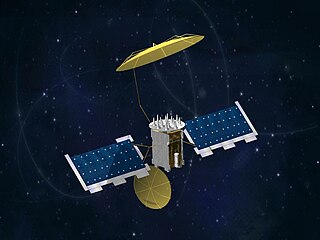Related Research Articles

Skynet is a family of military communications satellites, now operated by Airbus Defence and Space on behalf of the United Kingdom's Ministry of Defence (MoD). They provide strategic and tactical communication services to the branches of the British Armed Forces, the British intelligence agencies, some UK government departments and agencies, and to allied governments. Since 2015 when Skynet coverage was extended eastward, and in conjunction with an Anik G1 satellite module over America, Skynet offers near global coverage.

SSL, formerly Space Systems/Loral, LLC (SS/L), of Palo Alto, California, is a wholly owned manufacturing subsidiary of Maxar Technologies.

The Indian National Satellite System or INSAT, is a series of multipurpose geostationary satellites launched by ISRO to satisfy the telecommunications, broadcasting, meteorology, and search and rescue operations. Commissioned in 1983, INSAT is the largest domestic communication system in the Indo-Pacific Region. It is a joint venture of the Department of Space, Department of Telecommunications, India Meteorological Department, All India Radio and Doordarshan. The overall coordination and management of INSAT system rests with the Secretary-level INSAT Coordination Committee.

Telesat, formerly Telesat Canada, is a Canadian satellite communications company founded on May 2, 1969. The company is headquartered in Ottawa.

The Mobile User Objective System (MUOS) is an United States narrowband military communications satellite system that supports a worldwide, multi-service population of users in the ultra high frequency (UHF) band. The system provides increased communications capabilities to newer, smaller terminals while still supporting interoperability with legacy terminals. MUOS is designed to support users who require greater mobility, higher bit rates and improved operational availability. The MUOS was declared fully operational for use in 2019.
hispasat is the operating company for a number of Spanish communications satellites that cover the Americas, Europe and North Africa from orbital positions 30.0° West and 61.0° West. It was formed in 1989 and its activities include provision of communication services in the commercial and government sectors. Hispasat's fleet of satellites broadcast more than 1250 television channels and radio stations to more than 30 million homes, as well as providing services such as broadband to mobile telephones and landlines.

Inmarsat is a British satellite telecommunications company, offering global mobile services. It provides telephone and data services to users worldwide, via portable or mobile terminals which communicate with ground stations through fourteen geostationary telecommunications satellites. Inmarsat's network provides communications services to a range of governments, aid agencies, media outlets and businesses with a need to communicate in remote regions or where there is no reliable terrestrial network. The company was listed on the London Stock Exchange until it was acquired by Connect Bidco, a consortium consisting of Apax Partners, Warburg Pincus, the CPP Investment Board and the Ontario Teachers' Pension Plan, in December 2019.

Advanced Extremely High Frequency (AEHF) is a constellation of communications satellites operated by the United States Space Force. They are used to relay secure communications for the United States Armed Forces, the British Armed Forces, the Canadian Armed Forces, the Netherlands Armed Forces and the Australian Defence Force. The system consists of six satellites in geostationary orbits. The final satellite was launched on 26 March 2020. AEHF is backward compatible with, and replaces, the older Milstar system and will operate at 44 GHz uplink and 20 GHz downlink. The AEHF system is a joint service communications system that provides survivable, global, secure, protected, and jam-resistant communications for high-priority military ground, sea and air assets.
Intelsat 20 is a geostationary communications satellite which is operated by Intelsat. It was constructed by Space Systems/Loral, and is based on the LS-1300 satellite bus. It was launched on 2 August 2012, and replaces the Intelsat 7 and Intelsat 10 spacecraft at 68.5° East longitude. It is fully operational since September 2012.
The European Data Relay System (EDRS) system is a European constellation of GEO satellites that relay information and data between satellites, spacecraft, UAVs, and ground stations. The first components were launched in 2016 and 2019.
X band or SHF Satellite Communication is widely used by military forces for beyond line of sight communications. X band is used because it provides a compromise between the characteristics of different frequency bands which is particularly suited to the needs of military users. The characteristics include interference and rain resilience, terminal size, data rates, remote coverage and whether it is reserved for governmental use.

AsiaSat 8 then AMOS-7 is a Hong Kong-turned-Israeli geostationary communications satellite which is operated by the Asia Satellite Telecommunications Company (Asiasat).
Spainsat is a Spanish telecommunications satellite used for military and government communications. It allows telecommunications the different missions of the Spanish Armed forces abroad by providing coverage on a wide area of the world ranging from the United States and South America to the Middle East, including Africa and Europe.
JCSAT-2B, known as JCSAT-14 before commissioning, is a geostationary communications satellite operated by SKY Perfect JSAT Group and designed and manufactured by SSL on the SSL 1300 platform. It had a launch weight of 4,696.2 kg (10,353 lb), a power production capacity of 9 to 9.9 kW at end of life and a 15-year design life. Its payload is composed of 26 C band and 18 Ku band transponders with a total bandwidth of 2,853 MHz.
JCSAT-1B, known as JCSAT-5 before launch, is a geostationary communications satellite operated by SKY Perfect JSAT Group (JSAT) which was designed and manufactured by Hughes on the HS-601 satellite bus. It has a pure Ku-band payload and was used to replace JCSAT-1 at the 150° East longitude. It covers Japan, Korea, most of China, Thailand, Vietnam, Laos, part of Indonesia, part of Malaysia and Hawaii.
Superbird-A1, also identified as Superbird-1A before launch, was a geostationary communications satellite designed and manufactured by Ford Aerospace on the SSL 1300 satellite bus. It was originally ordered by Space Communications Corporation (SCC), which later merged into the SKY Perfect JSAT Group. It had a mixed Ku-band and Ka-band payload and operated on the 158° East longitude.
Intelsat 36, also known as IS-36, is a geostationary communications satellite operated by Intelsat and designed and manufactured by Space Systems/Loral on the SSL 1300 satellite bus. It covers Sub-Saharan Africa and South Asia from the 68.5° East longitude, providing media and content distribution with the South Africa MultiChoice company as anchor customer. It has a mixed C-band and Ku-band.

Paz is a Spanish Earth observation and reconnaissance satellite launched on 22 February 2018. It is Spain's first spy satellite. The satellite is operated by Hisdesat. Paz was previously referred to as SEOSAR.
The XTAR-EUR is a communication satellite developed by Spain and the USA and in order to provide a secure channel over the Indian Ocean. It is operated by XTAR and Hisdesat Its launch short after the Spainsat is part of an effort to strengthen Spain's communication ties with allied countries around the globe, particularly in maters of national security.
Spainsat NG is a Spanish communications satellite program aimed at developing next-generation satellites to meet Spain's government and military secure communications needs.
References
- ↑ "United Nations Outer Space Affairs Report" (PDF). www.oosa.unvienna.org. United Nations. p. 4. Retrieved 7 July 2014.
- ↑ Bruce Elbert (2004). The Satellite Communication Applications Handbook. Artech house. p. 62. ISBN 978-1-58053-808-4.
- ↑ "Loral Space & Communications". Loral Space & Communications. Retrieved 7 July 2014.
- ↑ ERIK SCHECHTER (June 17, 2014). "Private SATCOM's Promise". C4ISR & Networks. Archived from the original on July 14, 2014. Retrieved 7 July 2014.
- ↑ Caleb Henry (February 12, 2014). "Demand for X-band to Persist Despite US Military Drawbacks". Via Satellite. Access Intelligence. Retrieved 7 July 2014.
- ↑ "HoPS Program FBO". Federal Business Opportunities. GSA. Retrieved 7 July 2014.
- ↑ "Office of Space Commercialization". NOAA. Archived from the original on June 25, 2014. Retrieved 7 July 2014.
- ↑ "XTAR EUR listing on Satbeams". Satbeams. Retrieved 7 July 2014.
- ↑ "XTAR LANT listing on Satbeams". Satbeams. Retrieved 7 July 2014.
- ↑ "Link to GSA Schedule". GSA Library. Retrieved 7 July 2014.